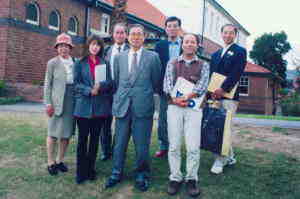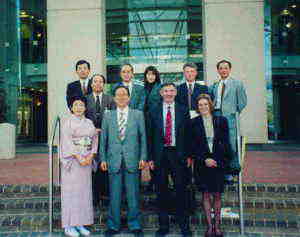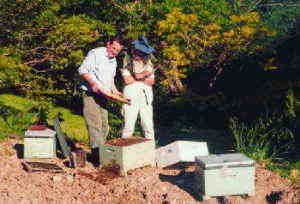|
Written
by Yoko Ishizuka
Translated into English
by Yoshikazu Kondo
Our Mayor visited Australia in October with two members of Japan-Australia
Society of Joetsu, namely Yoshi and myself. I have written the following
about the trip.
On October 8, we left Narita. On the morning of the 9th, we visited
the Sydney 2000 Olympic site and the office of SOCOG, an acronym for Sydney
Organising Committee for the Olympic Games, to listen to a presentation
regarding volunteers and environmental issues for the Games. At 1
p.m., we attended a luncheon which included such guests as Mr. and Mrs.
Jack Mudie, Mr. John Robertson, Mrs. Marjorie Anderson, Mr. and Mrs. John
Cook, Mrs. Joy Lee, Mrs. Pat Hole, and Mr. Rod Yates, some of whom were
ex-POWs and others relatives of ex-POWs. All the invitees seemed to have
enjoyed it very much. I felt quite relieved that the most important event
for us had passed with ease. I was told to pass their best regards
to the Joetsu people.

At Homebush, which is the mail Olympic site in
2000
The following day, October 10, we left for Cowra. We met Mayor
of Cowra and Mrs. Libby Reed, who was the Manager of the Cowra Japanese
Garden. With their cooperation, our Mayor planted a cherry tree at
a place near the former POW Campsite. That evening, we had a dinner
party with, amongst others, the Cowra Mayor and Mr. Takahashi, the new
Japanese ambassador to Australia, who had arrived in the country only a
few days before. In total there were about fifty Japanese and Australians
in attendance. When some people started playing the
shamisen
and shakuhachi, the party really began to get livelier.
On October 11, we attended a memorial service at the Australian and
Japanese Cemetery after which we attended a luncheon. Using the excuse
that Roger had come all the way from Molong to see us, Yoshi and I slipped
out from the luncheon, and three of us went to a restaurant in town together.
At 2 p.m., we left for Canberra by bus. On October 12, some members
of the Canberra Australia-Japan Society showed us around the Australian
War Memorial Museum. The museum's Director and Superintendents waited
for us and allowed us to enter before opening time. After Mayor laid
a wreath on the "Tomb of The Unknown Soldiers," they led us through the
exhibition areas. Among all the fallen soldiers' names inscribed
on the wall, we found the name, Lt. Colonel A. Robertson.
In the following meeting with Ms. Kate Carnell, Chief Minister, she
remembered me and, to my surprise, greeted me, calling "Yoko". I
had met her two months previously, making it the fourth time we had met
each other. She evaluated the citizen's movement in Joetsu as the
driving force, which erected the statues of Peace and Friendship at the
former POW campsite. The discussion between the two Mayors was so
lively that our time seemed to pass much too quickly. I actually
felt uneasy that our Mayor had continued talking to her so long.
Following that, we were treated to a formal luncheon with senior officials
of DFAT, the Department of Foreign Affairs and Trade. I enjoyed it
because I was able to meet Mr. Bill Paterson and Ms. Glenda Gauci, whom
I had showed around in Joetsu when they had visited us. He said the
most impressive event he attended in Japan had been the one held in Joetsu.
Accordingly, I made a mental note to ensure I would convey his thoughtful
message to the people of Joetsu.
After the luncheon, hosted by Alan Thomas of the Department of Foreign
Affairs and Trade, we had a round-table conference concerning trade-resources
between Japan and Australia. The Manager of the DFAT Japan Section
was Mr. John Woods, whose father was a POW in Japan. I informed him
that we had built the statues at the park and also asked him to hand to
his father, the doll that I had brought with me from Japan.

At DFAT
We invited the President of ACT (Australian Capital Territory) Australia-Japan
Society, its two Vice Presidents, and an ex-President to dinner that evening,
which gave us an opportunity to thank them for their favor in recent times.
The next morning, we got up early to catch a small plane to Sydney,
where we visited the regatta course which would be used for the upcoming
2000 Olympics. Our lunch was held at a restaurant atop Sydney Tower.
We dined that evening with Rod at a Japanese restaurant, which Mr. Somukawa
from Takada had kindly reserved for us in advance.
Following that, Mayor and the city officials headed for Sydney airport,
and Yoshi and I accompanied Rod to his home. We spent 3 relaxing
days at Rod's place which was still undergoing some construction.
On the first day of our own itinerary, being independent of the formal
one, we visited Jack's home and on the second day, John's and enjoyed their
respective company very much. On the third day, Yoshi and I went
to the City by train to do some shopping. Upon our return, we took
both the train and the bus, thoroughly enjoying the adventure.

I tried to take out honey from hives: HORRIBLE!
Rod took a good deal of time away from his work to drive us around,
for which we were truly grateful. Although we must have been quite
some trouble to him, he never let his displeasure show. He even looked
as though he was enjoying himself as much as we were; actually, he said
when his home was completed, he would accept Japanese people who visited
Australia for study or homestay. Anyone with such goals in mind,
I urge you to visit him.
In the evening of October 16, Rod, John and Terri came to the airport
to see us off. Although we were heading home, we felt as though we
had left a part of our heart behind in Australia.
Now that I am back home in Japan, I play with our grandchildren as Grandma,
feeling the "Rip Van Winkle effect" has really taken its toll on me.
Nevertheless, I muse to myself without any regret at all that I never acted
my age in Australia.
|